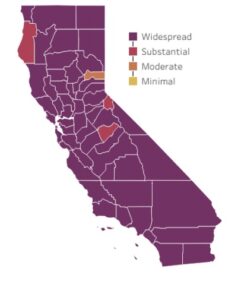New Covid cases per day have now increased by more than 20x in the city of Santa Barbara since the beginning of November, according to the most recent Covid local status reports from the Santa Barbara County Department of Public Health. Some of the increase is due to almost twice as much testing happening now than November, as more tests discover more cases. Still, most new cases are due to the recent significant increase in Covid positivity rates, that is, the percentage of total tests now coming back positive for Covid. For example, between December 30th, 2020 to January 3rd, 2021, the average Santa Barbara County Covid positivity rate was 14%. Over a similar period at the beginning of November, the Santa Barbara Count positivity rate was 1.73%. Statewide Covid new case numbers overall have also increased significantly, with the increase driving Covid-related hospitalizations and mortalities. Also, as hospital critical care capacity declines across Southern California due to Covid, mortality rates for Covid patients and for patients with other dangerous non-Covid conditions will likely go up.
Governor Gavin Newsom has now issued new emergency guidelines that significantly affect and limit individual, business, and community activity. However, Newsom is facing resistance to these new rules and even a possible recall campaign. Newsom, specifically, has received criticism for several perceived hypocritical actions. In late October, Newsom sent his kids back to in-person private school when almost all public schools were still closed. In the first part of November, Newsom attended a medium-sized dinner party with, among others, California Medical Association lobbyists, at a Napa restaurant about two weeks before publicly stating that people should not gather for Thanksgiving with more than three sets of family members. Newsom was recently aware that one of his children’s u12 soccer teams traveled to Arizona to attend a Thanksgiving weekend soccer tournament about ten days before he issued a directive that traveling out of state for sports tournaments was not allowed. How does Newsom’s example as governor affect California’s ability to address the Covid outbreak?
Willie Brown, a former Democratic mayor of San Francisco who appointed Newsom to the San Francisco Board of Supervisors, said in mid-December, “As we enter this darkest phase of the pandemic, it is more important than ever that people follow the safety rules being laid down by our health and political leaders. But when those leaders order shutdowns with no science to back them up, people who demand explanations and get no answers can lose faith that they’re being given the straight story.” Speaking about attending the dinner party, Newsom said, “I made a bad mistake… The spirit of what I’m preaching all the time was contradicted. I need to preach and practice, not just preach.”
This brings us to the California Youth Sports Guidance updated by Newsom in mid-December. Last Spring, the three governors of Washington, Oregon, and California announced a Covid policy-making partnership and wrote in a joint statement, “COVID-19 has preyed upon our interconnectedness. In the coming weeks, the West Coast will flip the script on COVID-19 – with our states acting in close coordination and collaboration to ensure the virus can never spread wildly in our communities.” Both Oregon and Washington issued youth sports guidance in May, limiting interaction between athletes through the summer but then loosening their restrictions in September to allow some sports to play games, with sideline requirements for distancing and the wearing of masks, and modified travel to and from games. However, California only issued initial youth sports guidance in the first week of August. It did not allow any sports to play games through the Fall when almost every state in the US – including Oregon and Washington – allowed some sports to play. As a direct result of California shutting down all youth sports, thousands of California families, particularly those with pre-college age kids, traveled to Nevada and Arizona for games and tournaments, even as those states had, at the time, Covid positivity rates up to 3x higher than California. Also, California, in its updated youth guidance provided in mid-December, again deviated from generally accepted guidance, provided back in mid-May by the National Federation of State High School Associations (NFHS) Sports Medicine Advisory Committee (SMAC) for grouping different sports into different areas of risk based on specific criteria.
NFHS risk criteria and groupings:
Higher Risk: Sports that involve close, sustained contact between participants, lack of significant protective barriers, and high probability that respiratory particles will be transmitted between participants.
Examples: Wrestling, football, boys lacrosse, and competitive cheer
Moderate Risk: Sports that involve close, sustained contact, but with protective equipment in place that may reduce the likelihood of respiratory particle transmission between participants OR intermittent close contact OR sports that use equipment that can’t be cleaned between participants.
Examples: Basketball, volleyball, baseball, softball, soccer, water polo, tennis, swimming relays, some track events, and girls lacrosse.
Lower Risk: Sports that can be done with social distancing or individually with no sharing of equipment or the ability to clean the equipment between use by competitors.
Examples: Most track events, individual swimming, golf, sideline cheer, and cross country running
Despite Oregon and Washington following the NFHS groupings and guidance almost verbatim, the California youth sports guidance issued in December deviated in crucial areas, especially for Santa Barbara. Specifically, California grouped soccer, basketball, volleyball, and water polo in the same higher risk category as football, boys lacrosse, and rugby.
Per the current California guidelines for opening, none of these higher-risk sports will be able to play games until a county reaches “Orange” status, which is no more than 3.9 new cases reported per day per 100,000 people in a given county. For reference, per Santa Barbara county department of public health reports, Santa Barbara county has not been at “Orange” since the beginning of the Covid outbreak in March. However, if California changed its grouping for soccer, basketball, volleyball, and water polo to align with the guidance from NFHS, putting these sports into the same category as baseball and softball, these sports would be able to restart play once their county entered into the “Red” status. Santa Barbara county was in “Red” status – between 4 to 7 new cases reported per 100,000 people – for most of the Spring and most of the Fall.
The critical criteria for sports like soccer being grouped seem to be the science and data – or lack thereof – defining “intermittent” contact sports. While California has chosen to define soccer as a “sustained” contact sport, according to a Denmark study done early in the pandemic when European soccer was considering restarting, older age group soccer definitively falls into the “intermittent” contact category. The Danish study – completed in early May by professors from the Department of Public Health – Sports at Aarhus University using video analysis of 14 games – found that on average, soccer players experience less than two minutes of close contact during an average match. Since this study was released, almost all reported professional soccer player Covid cases have been traced back to social gatherings, not field play. The Department of Orthopedics and Rehabilitation at the University of Wisconsin School of Medicine and Public Health completed a study of more than 90,000 youth soccer players across more than 120 clubs playing competitive soccer in more than 34 states over the summer, from mid-June through late August.
One of the key findings was that just four new Covid cases per day per 100,000 children were reported, which was about -40% less than the overall nationwide infection rate for children across the US – per the American Academy of Pediatric – during the same period of time. And of the player cases reported, just one Covid case was traced back to a transmission that occurred during soccer. Also, the study surveyed clubs on their Covid mitigation plans. Top measures were reasonably straightforward, player symptom monitoring, social distancing on the sideline, wearing masks on the sideline, and staggered arrival and departures at fields. In addition, the study surveyed youth soccer players’ activity levels and mental health before and after the Covid-19. The survey found that activity levels among soccer players where play had been prohibited had dropped by 50%. The survey also found that that – post-Covid – reported depression among players had more than tripled, with 38% now reporting moderate to severe depression and 35% reporting severe anxiety. Per the Mayo Clinic, one of the top forms of non-pharmaceutical treatment for depression and anxiety is physical activity. In the Santa Barbara and Goleta area, totaling up player rosters from the websites of the Santa Barbara Soccer Club, Legends Futbol Academy, the Santa Barbara Revolution Youth Soccer League, the local AYSO league and then comparing the total number of soccer players to the total number of children ages 6 to 16 per the US Census, more than one in five children in the Santa Barbara area play some form of organized soccer. But, looking at the Covid numbers and what the California Youth Sports Guidance currently dictates, Santa Barbara will likely not be playing soccer games and some other sports until summer 2021 at the earliest, despite the science and data. It is also difficult not to wonder that if soccer games were an option back in the Fall to help maintain youth mental health, then events like 25% of all Santa Barbara students receiving a D or an F grade in the Fall quarter, or the Westside stabbings and the Eastside shootings could have been avoided.







Be First to Comment